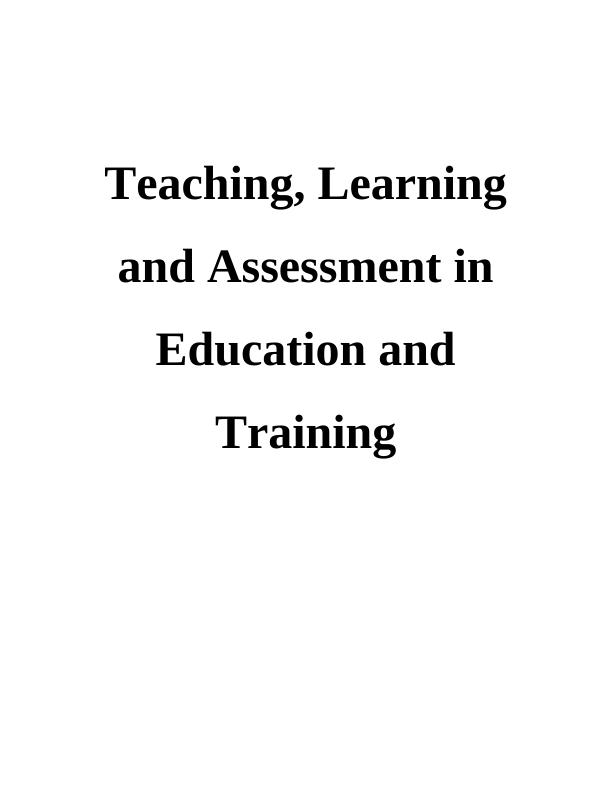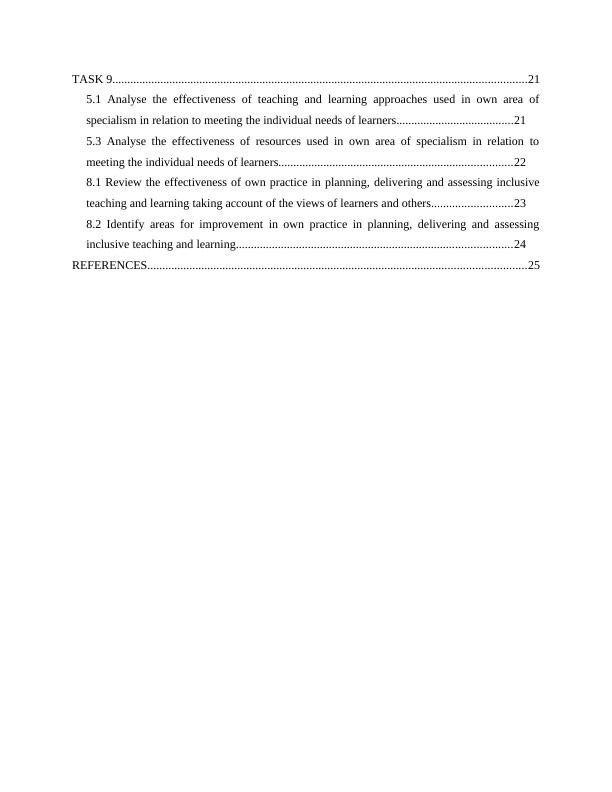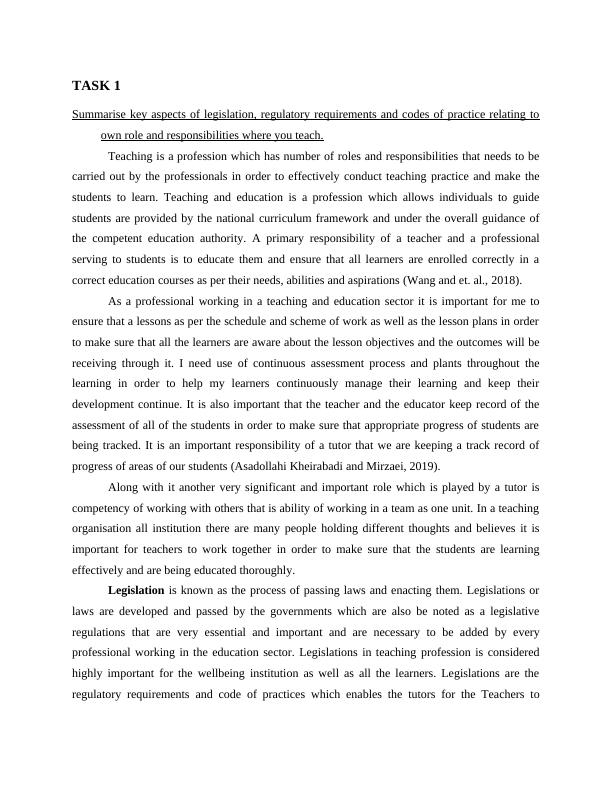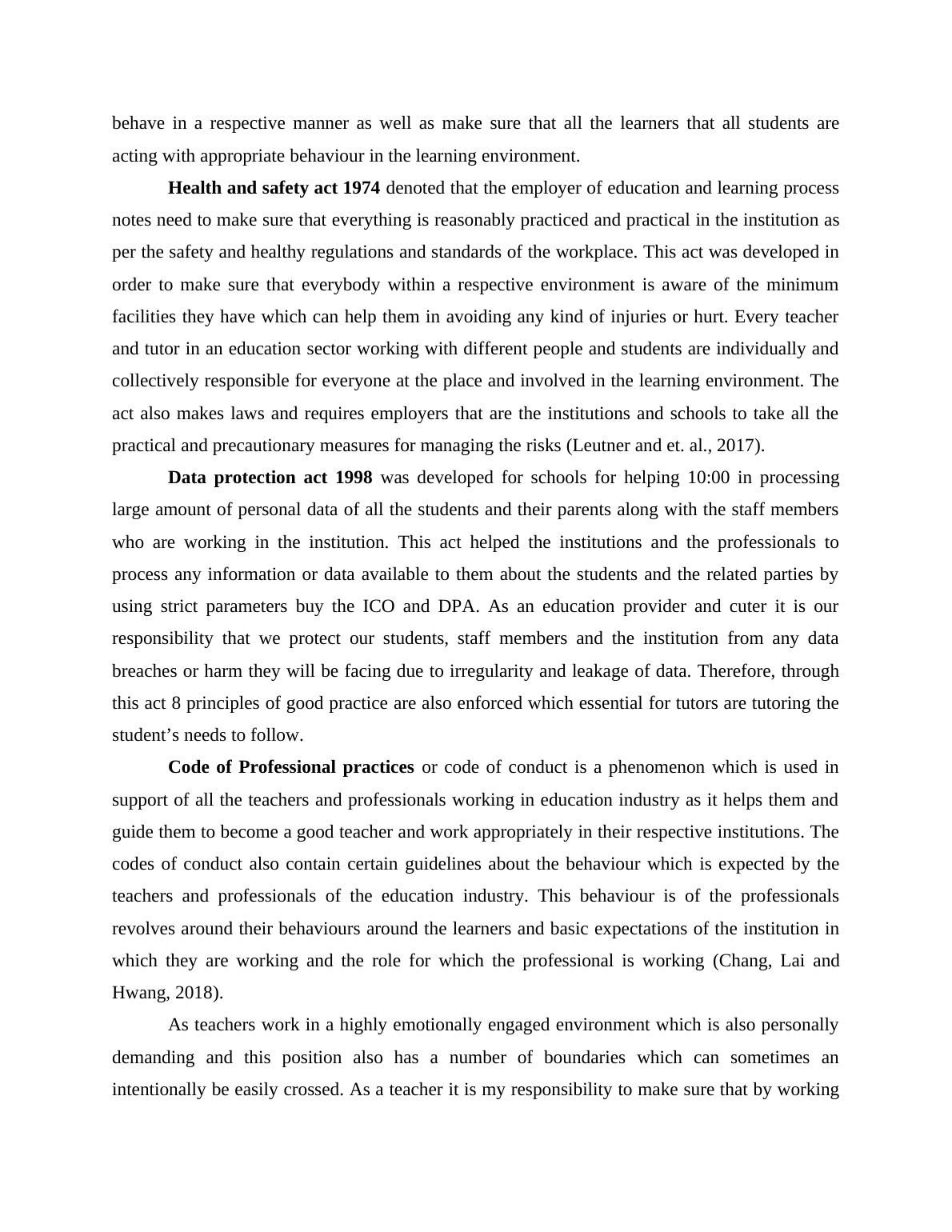Teaching, Learning and Assessment in Education and Training
26 Pages9470 Words146 Views
Added on 2022-11-29
About This Document
This document discusses the key aspects of legislation, regulatory requirements, and codes of practice in education and training. It emphasizes the importance of promoting appropriate behavior, equality, and diversity. It also provides insights on how to establish a safe and inclusive learning environment. Additionally, it explains the significance of identifying and meeting the individual needs of learners through initial and diagnostic assessments.
Teaching, Learning and Assessment in Education and Training
Added on 2022-11-29
ShareRelated Documents
Teaching, Learning
and Assessment in
Education and
Training
and Assessment in
Education and
Training

Table of Content
TASK 1............................................................................................................................................4
Summarise key aspects of legislation, regulatory requirements and codes of practice relating
to own role and responsibilities where you teach...................................................................4
TASK 2............................................................................................................................................6
3.5 Identify opportunities for learners to provide feedback to inform inclusive practice......6
4.1 Explain why it is important to promote appropriate behaviour and respect for others....7
4.2 Explain ways to promote equality and value diversity.....................................................7
4.3 Establish and sustain a safe, inclusive learning environment...........................................8
TASK 3............................................................................................................................................8
Explain why it is important to identify and meet your individual needs of learners. Analysis of
the role and use of initial and diagnostic assessment in agreeing individual learning goals with
your learners...........................................................................................................................8
TASK 4..........................................................................................................................................12
3.1 Devise a scheme of work in accordance with internal and external requirements.........12
TASK 5..........................................................................................................................................13
Design teaching and learning plans that respond to, the individual goals and needs of all
learners and curriculum requirements..................................................................................14
TASK 6..........................................................................................................................................14
3.3 Explain how own planning meets the individual needs of learners...............................14
3.4 Explain ways in which teaching and learning plans can be adapted to meet the individual
needs of learners...................................................................................................................15
5.6 Adapt teaching and learning approaches and resources, including technologies to meet the
individual needs of learners..................................................................................................15
TASK 7..........................................................................................................................................17
6.1 Explain the purposes and types of assessment used in education and training..............17
6.2 Analyse the effectiveness of assessment methods in relation to meeting the individual
needs of learners...................................................................................................................18
TASK 8..........................................................................................................................................18
5.2 Analyse benefits and limitations of communication methods and media used in own area
of specialism.........................................................................................................................18
TASK 1............................................................................................................................................4
Summarise key aspects of legislation, regulatory requirements and codes of practice relating
to own role and responsibilities where you teach...................................................................4
TASK 2............................................................................................................................................6
3.5 Identify opportunities for learners to provide feedback to inform inclusive practice......6
4.1 Explain why it is important to promote appropriate behaviour and respect for others....7
4.2 Explain ways to promote equality and value diversity.....................................................7
4.3 Establish and sustain a safe, inclusive learning environment...........................................8
TASK 3............................................................................................................................................8
Explain why it is important to identify and meet your individual needs of learners. Analysis of
the role and use of initial and diagnostic assessment in agreeing individual learning goals with
your learners...........................................................................................................................8
TASK 4..........................................................................................................................................12
3.1 Devise a scheme of work in accordance with internal and external requirements.........12
TASK 5..........................................................................................................................................13
Design teaching and learning plans that respond to, the individual goals and needs of all
learners and curriculum requirements..................................................................................14
TASK 6..........................................................................................................................................14
3.3 Explain how own planning meets the individual needs of learners...............................14
3.4 Explain ways in which teaching and learning plans can be adapted to meet the individual
needs of learners...................................................................................................................15
5.6 Adapt teaching and learning approaches and resources, including technologies to meet the
individual needs of learners..................................................................................................15
TASK 7..........................................................................................................................................17
6.1 Explain the purposes and types of assessment used in education and training..............17
6.2 Analyse the effectiveness of assessment methods in relation to meeting the individual
needs of learners...................................................................................................................18
TASK 8..........................................................................................................................................18
5.2 Analyse benefits and limitations of communication methods and media used in own area
of specialism.........................................................................................................................18

TASK 9..........................................................................................................................................21
5.1 Analyse the effectiveness of teaching and learning approaches used in own area of
specialism in relation to meeting the individual needs of learners.......................................21
5.3 Analyse the effectiveness of resources used in own area of specialism in relation to
meeting the individual needs of learners..............................................................................22
8.1 Review the effectiveness of own practice in planning, delivering and assessing inclusive
teaching and learning taking account of the views of learners and others...........................23
8.2 Identify areas for improvement in own practice in planning, delivering and assessing
inclusive teaching and learning............................................................................................24
REFERENCES..............................................................................................................................25
5.1 Analyse the effectiveness of teaching and learning approaches used in own area of
specialism in relation to meeting the individual needs of learners.......................................21
5.3 Analyse the effectiveness of resources used in own area of specialism in relation to
meeting the individual needs of learners..............................................................................22
8.1 Review the effectiveness of own practice in planning, delivering and assessing inclusive
teaching and learning taking account of the views of learners and others...........................23
8.2 Identify areas for improvement in own practice in planning, delivering and assessing
inclusive teaching and learning............................................................................................24
REFERENCES..............................................................................................................................25

TASK 1
Summarise key aspects of legislation, regulatory requirements and codes of practice relating to
own role and responsibilities where you teach.
Teaching is a profession which has number of roles and responsibilities that needs to be
carried out by the professionals in order to effectively conduct teaching practice and make the
students to learn. Teaching and education is a profession which allows individuals to guide
students are provided by the national curriculum framework and under the overall guidance of
the competent education authority. A primary responsibility of a teacher and a professional
serving to students is to educate them and ensure that all learners are enrolled correctly in a
correct education courses as per their needs, abilities and aspirations (Wang and et. al., 2018).
As a professional working in a teaching and education sector it is important for me to
ensure that a lessons as per the schedule and scheme of work as well as the lesson plans in order
to make sure that all the learners are aware about the lesson objectives and the outcomes will be
receiving through it. I need use of continuous assessment process and plants throughout the
learning in order to help my learners continuously manage their learning and keep their
development continue. It is also important that the teacher and the educator keep record of the
assessment of all of the students in order to make sure that appropriate progress of students are
being tracked. It is an important responsibility of a tutor that we are keeping a track record of
progress of areas of our students (Asadollahi Kheirabadi and Mirzaei, 2019).
Along with it another very significant and important role which is played by a tutor is
competency of working with others that is ability of working in a team as one unit. In a teaching
organisation all institution there are many people holding different thoughts and believes it is
important for teachers to work together in order to make sure that the students are learning
effectively and are being educated thoroughly.
Legislation is known as the process of passing laws and enacting them. Legislations or
laws are developed and passed by the governments which are also be noted as a legislative
regulations that are very essential and important and are necessary to be added by every
professional working in the education sector. Legislations in teaching profession is considered
highly important for the wellbeing institution as well as all the learners. Legislations are the
regulatory requirements and code of practices which enables the tutors for the Teachers to
Summarise key aspects of legislation, regulatory requirements and codes of practice relating to
own role and responsibilities where you teach.
Teaching is a profession which has number of roles and responsibilities that needs to be
carried out by the professionals in order to effectively conduct teaching practice and make the
students to learn. Teaching and education is a profession which allows individuals to guide
students are provided by the national curriculum framework and under the overall guidance of
the competent education authority. A primary responsibility of a teacher and a professional
serving to students is to educate them and ensure that all learners are enrolled correctly in a
correct education courses as per their needs, abilities and aspirations (Wang and et. al., 2018).
As a professional working in a teaching and education sector it is important for me to
ensure that a lessons as per the schedule and scheme of work as well as the lesson plans in order
to make sure that all the learners are aware about the lesson objectives and the outcomes will be
receiving through it. I need use of continuous assessment process and plants throughout the
learning in order to help my learners continuously manage their learning and keep their
development continue. It is also important that the teacher and the educator keep record of the
assessment of all of the students in order to make sure that appropriate progress of students are
being tracked. It is an important responsibility of a tutor that we are keeping a track record of
progress of areas of our students (Asadollahi Kheirabadi and Mirzaei, 2019).
Along with it another very significant and important role which is played by a tutor is
competency of working with others that is ability of working in a team as one unit. In a teaching
organisation all institution there are many people holding different thoughts and believes it is
important for teachers to work together in order to make sure that the students are learning
effectively and are being educated thoroughly.
Legislation is known as the process of passing laws and enacting them. Legislations or
laws are developed and passed by the governments which are also be noted as a legislative
regulations that are very essential and important and are necessary to be added by every
professional working in the education sector. Legislations in teaching profession is considered
highly important for the wellbeing institution as well as all the learners. Legislations are the
regulatory requirements and code of practices which enables the tutors for the Teachers to

behave in a respective manner as well as make sure that all the learners that all students are
acting with appropriate behaviour in the learning environment.
Health and safety act 1974 denoted that the employer of education and learning process
notes need to make sure that everything is reasonably practiced and practical in the institution as
per the safety and healthy regulations and standards of the workplace. This act was developed in
order to make sure that everybody within a respective environment is aware of the minimum
facilities they have which can help them in avoiding any kind of injuries or hurt. Every teacher
and tutor in an education sector working with different people and students are individually and
collectively responsible for everyone at the place and involved in the learning environment. The
act also makes laws and requires employers that are the institutions and schools to take all the
practical and precautionary measures for managing the risks (Leutner and et. al., 2017).
Data protection act 1998 was developed for schools for helping 10:00 in processing
large amount of personal data of all the students and their parents along with the staff members
who are working in the institution. This act helped the institutions and the professionals to
process any information or data available to them about the students and the related parties by
using strict parameters buy the ICO and DPA. As an education provider and cuter it is our
responsibility that we protect our students, staff members and the institution from any data
breaches or harm they will be facing due to irregularity and leakage of data. Therefore, through
this act 8 principles of good practice are also enforced which essential for tutors are tutoring the
student’s needs to follow.
Code of Professional practices or code of conduct is a phenomenon which is used in
support of all the teachers and professionals working in education industry as it helps them and
guide them to become a good teacher and work appropriately in their respective institutions. The
codes of conduct also contain certain guidelines about the behaviour which is expected by the
teachers and professionals of the education industry. This behaviour is of the professionals
revolves around their behaviours around the learners and basic expectations of the institution in
which they are working and the role for which the professional is working (Chang, Lai and
Hwang, 2018).
As teachers work in a highly emotionally engaged environment which is also personally
demanding and this position also has a number of boundaries which can sometimes an
intentionally be easily crossed. As a teacher it is my responsibility to make sure that by working
acting with appropriate behaviour in the learning environment.
Health and safety act 1974 denoted that the employer of education and learning process
notes need to make sure that everything is reasonably practiced and practical in the institution as
per the safety and healthy regulations and standards of the workplace. This act was developed in
order to make sure that everybody within a respective environment is aware of the minimum
facilities they have which can help them in avoiding any kind of injuries or hurt. Every teacher
and tutor in an education sector working with different people and students are individually and
collectively responsible for everyone at the place and involved in the learning environment. The
act also makes laws and requires employers that are the institutions and schools to take all the
practical and precautionary measures for managing the risks (Leutner and et. al., 2017).
Data protection act 1998 was developed for schools for helping 10:00 in processing
large amount of personal data of all the students and their parents along with the staff members
who are working in the institution. This act helped the institutions and the professionals to
process any information or data available to them about the students and the related parties by
using strict parameters buy the ICO and DPA. As an education provider and cuter it is our
responsibility that we protect our students, staff members and the institution from any data
breaches or harm they will be facing due to irregularity and leakage of data. Therefore, through
this act 8 principles of good practice are also enforced which essential for tutors are tutoring the
student’s needs to follow.
Code of Professional practices or code of conduct is a phenomenon which is used in
support of all the teachers and professionals working in education industry as it helps them and
guide them to become a good teacher and work appropriately in their respective institutions. The
codes of conduct also contain certain guidelines about the behaviour which is expected by the
teachers and professionals of the education industry. This behaviour is of the professionals
revolves around their behaviours around the learners and basic expectations of the institution in
which they are working and the role for which the professional is working (Chang, Lai and
Hwang, 2018).
As teachers work in a highly emotionally engaged environment which is also personally
demanding and this position also has a number of boundaries which can sometimes an
intentionally be easily crossed. As a teacher it is my responsibility to make sure that by working

in my profession I do not over cross or over step those invisible boundaries which are set by the
code of professional conduct.
Boundaries is an important part of education industry which also put number of
professional tutors in place to concentrate on their profession of teaching rather than involving in
other personal needs or requirements of their learner which actually is falling out of their actual
role. This practice can lead a teacher to follow appropriate guidance and ensuring that they were
for their learners onto the correct profession and within the appropriate organisation.
It is the responsibility of every working individual in education sector as a professional
and in different institutions such as schools, universities to make sure that the safety of the
learners is maintained and all the colleagues today working with them are feeling safe and secure
long with having the feeling of working in a highly collaborative environment.
TASK 2
3.5 Identify opportunities for learners to provide feedback to inform inclusive practice.
Learning process is a valuable practice which is needed to be effective and will only be
effective when teachers and learners are communicating appropriately and potentially with one
another. It is true that tutors and professors have higher authority in a class over his or her
learners. Therefore, it is their responsibility that they develop an environment which is
interactive and learning along with encouraging students to give proper feedback regarding their
learning as well as developments (Said, 2018).
Feedback is an essential and important aspect of education and training sector as it enable
the tutors to understand the requirements as well as progress that are being made by their
students and assist them in making Future plans. There are several opportunities for students and
learners to provide feedback in order to inform inclusive teaching practice.
The first practice needs to be undertaken by the teacher by keeping all individual learners
engaged in collaborative conversations within the class. Dance practice helps the learners
to learn about how to make a collaborative conversation and be interactive within the
class (Van Wyk, 2017).
Another practice which provides opportunity to learners for offering their feedback is
conducting regular feedback sessions before beginning a class or after completing a
code of professional conduct.
Boundaries is an important part of education industry which also put number of
professional tutors in place to concentrate on their profession of teaching rather than involving in
other personal needs or requirements of their learner which actually is falling out of their actual
role. This practice can lead a teacher to follow appropriate guidance and ensuring that they were
for their learners onto the correct profession and within the appropriate organisation.
It is the responsibility of every working individual in education sector as a professional
and in different institutions such as schools, universities to make sure that the safety of the
learners is maintained and all the colleagues today working with them are feeling safe and secure
long with having the feeling of working in a highly collaborative environment.
TASK 2
3.5 Identify opportunities for learners to provide feedback to inform inclusive practice.
Learning process is a valuable practice which is needed to be effective and will only be
effective when teachers and learners are communicating appropriately and potentially with one
another. It is true that tutors and professors have higher authority in a class over his or her
learners. Therefore, it is their responsibility that they develop an environment which is
interactive and learning along with encouraging students to give proper feedback regarding their
learning as well as developments (Said, 2018).
Feedback is an essential and important aspect of education and training sector as it enable
the tutors to understand the requirements as well as progress that are being made by their
students and assist them in making Future plans. There are several opportunities for students and
learners to provide feedback in order to inform inclusive teaching practice.
The first practice needs to be undertaken by the teacher by keeping all individual learners
engaged in collaborative conversations within the class. Dance practice helps the learners
to learn about how to make a collaborative conversation and be interactive within the
class (Van Wyk, 2017).
Another practice which provides opportunity to learners for offering their feedback is
conducting regular feedback sessions before beginning a class or after completing a

End of preview
Want to access all the pages? Upload your documents or become a member.
Related Documents
Teaching, Learning & Assessment in Education and Traininglg...
|25
|7860
|201
Education and Training - Doclg...
|42
|12358
|114
Teaching Learning and Assessment in Education and Training (Pass Criteria)lg...
|28
|9236
|449
Planning to Meet the Needs of Learners in Education and Traininglg...
|31
|7484
|125
Teaching, Learning and Assessment in Education and Traininglg...
|32
|9916
|35
Role of the teacher in planning teaching and assessinglg...
|18
|5098
|149
